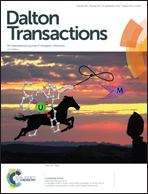Fine tuning of catalytic and sorption properties of metal–organic frameworks via in situ ligand exchange†
Abstract
Metal–organic frameworks (MOFs) are gaining considerable attention not only because of their diverse structures but also due to their interesting properties and potential applications. However, fabrication of MOFs with desired structures and properties remains a great challenge. In this study, a strategy based on ligand exchange via single-crystal-to-single-crystal (SCSC) transformation has been undertaken, which can be used to achieve MOFs not available by direct synthesis and also to enrich the family of isoreticular MOFs. Direct X-ray crystallographic observation provides undoubted evidence that the pyrazine (pyz) ligand in [Cu3(L)2(pyz)(H2O)] (L3− = [1,1′:3′,1′′-terphenyl]-4,4′′,5′-tricarboxylate) was replaced by its derivatives without damaging the framework. Furthermore, the catalytic and sorption properties of the MOFs are able to be fine-tuned by introducing definite substituent group decorated on the pore surface. Thus, it is expected that the ligand exchange will be powerful for replacing linker molecules with others having desirable substituents, and as a result to afford desired MOFs.



 Please wait while we load your content...
Please wait while we load your content...